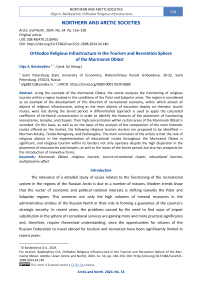Orthodox Religious Infrastructure in the Tourism and Recreation Sphere of the Murmansk Oblast
Автор: Balabeykina O.A.
Журнал: Arctic and North @arctic-and-north
Рубрика: Northern and arctic societies
Статья в выпуске: 54, 2024 года.
Бесплатный доступ
Using the example of the Murmansk Oblast, the article analyzes the functioning of religious tourism within a region located in the conditions of the Polar and Subpolar areas. The region is considered as an example of the development of this direction of recreational economy, within which almost all objects of religious infrastructure, acting as the main objects of excursion display on thematic tourist routes, were lost during the Soviet period. A differentiated approach is used to apply the calculated coefficient of territorial concentration in order to identify the features of the placement of functioning monasteries, temples, and chapels. Their high concentration within certain areas of the Murmansk Oblast is recorded. On this basis, as well as on the basis of the analysis of the composition of the main thematic routes offered on the market, the following religious tourism clusters are proposed to be identified — Murman-Kolskiy, Tersko-Beregovoy, and Pechengskiy. The main conclusion of the article is that the role of religious objects in the implementation of educational routes throughout the Murmansk Oblast is significant, and religious tourism within its borders not only operates despite the high dispersion in the placement of monasteries and temples, as well as the losses of the Soviet period, but also has prospects for the introduction of innovative forms.
Murmansk Oblast, religious tourism, tourist-recreational cluster, educational tourism, multiplicative effect
Короткий адрес: https://sciup.org/148329512
IDR: 148329512 | УДК: 338.48(470.21)(045) | DOI: 10.37482/issn2221-2698.2024.54.140
Список литературы Orthodox Religious Infrastructure in the Tourism and Recreation Sphere of the Murmansk Oblast
- Kondrateva S.V. National Tourist Rating of Russian Regions: Typological Diversity. RUDN Journal of Economics, 2022, vol. 30, no. 1, pp. 45–56. DOI: https://doi.org/10.22363/2313-2329-2022-30-1-45-56
- Hadieva R.T., Semeniuk N.V. Pilgrimage as a Perspective Trend in a Tourism Industry. Physical Cul-ture. Sport. Tourism. Motor Recreation, 2017, vol. 2, no. 1, pp. 95–99.
- Markin K.V. Between Belief and Unbelief: Non-Practicing Orthodox Christians in the Context of the Russian Sociology of Religion. Monitoring of Public Opinion: Economic and Social Changes, 2018, no. 2 (144), pp. 274–290. DOI: https://doi.org/10.14515/monitoring.2018.2.16.
- Lunkin R.N., Filatov S.B. Interconfessional Differences in Europe and New Ideological Withstanding. Contemporary Europe, 2018, no. 3 (82), pp. 102–114. DOI: http://dx.doi.org/10.15211/soveurope32018102114
- Balabeykina O.A., Yankovskaya A.A., Korobushchenko V.Yu. Religious Organization in Sustainable Development of Regions: The Case of Diocese Viborg of the Evangelic Lutheran Church of Denmark. The North and the Market: Forming the Economic Order, 2022, no. 1, pp. 84–95. DOI: https://doi.org/10.37614/2220-802X.1.2022.75.007
- Ivanov I.A., Mikhaylov B.S. Structure and Geography of the Inbound Tourist Flow Distribution in Norway. Pskov Journal of Regional Studies, 2020, iss. 4 (44), pp. 107–118. DOI: https://doi.org/10.37490/S221979310011436-2
- Manakov A.G., Krasilnikova I.N., Ivanov I.A. Geography of Inbound Tourism and Transboundary Tourism-and-Recreation Region Building in Sweden. Baltic Region, 2021, vol. 13, no. 1, pp. 108–123. DOI: https://doi.org/10.5922/2079–8555-2021-1-6
- Afanasiev O.E. Tourism in the Antarctic Region: The Pole of Geopolitical Interests. Service And Tour-ism: Current Challenges, 2022, vol. 16, no. 1, pp. 89–112. DOI: https://doi.org/10.24412/1995-0411-2022-1-89-112
- Bertosh A.A. Arctic Tourism: Conceptual Features and Particularities. Transactions of Kola Science Centre RAS, 2019, no. 7 (17), pp. 169–180. DOI: https://doi.org/10.25702/KSC.2307-5252.2019.7.169-180
- Liggett D., Stewart E. The Changing Face of Political Engagement in Antarctic Tourism. In: Handbook on the Politics of Antarctica. Cheltenham, Edward Elgar Publishing Limited, 2017, pp. 368–391. DOI: https://doi.org/10.4337/9781784717681.00036
- Zhelnina Z.Yu. Tourism of the Murmansk Region as a Driver of Territory Development. Society: Poli-tics, Economics, Law, 2021, no. 9, pp. 65–75. DOI: https://doi.org/https://doi.org/10.24158/pep.2021.9.11
- Bertosh A.A. Material Historical and Cultural Heritage in the Development of Tourism Industry of the Arctic Zone of the Russian Federation (On the Example of the Murmansk Region): General Statement of the Problem. Transactions of Kola Science Centre RAS, 2018, no. 11–15 (9), pp. 145–153. DOI: https://doi.org/10.25702/KSC.2307-5252.2018.9.11.145-153
- Davydova A.S. Reproduction of the Sacred Landscape of Teriberka in the Context of Tourism Devel-opment in the Murmansk Region. Transactions of Kola Science Centre RAS, 2021, vol. 12, no. 4 (21), pp. 126–140. DOI: https://doi.org/10.37614/2307-5252.2021.4.21.009
- Balabeikina O.A., Gavrilova K.S., Kuznetsova Ju.A. Religious Tourism as a Component of the Arkhan-gelsk Region Branding. The North and the Market: Forming the Economic Order, 2021, no. 3 (73), pp. 118–127. DOI: https://doi.org/10.37614/2220-802X.3.2021.73.008
- Kirosova T.A. Religioznyy turizm kak vid sotsial'nogo predprinimatel'stva v Respublike Komi: ten-dentsii razvitiya [Religious Tourism as a Type of Social Entrepreneurship in the Komi Republic: De-velopment Trends]. In: Sotsial'noe predprinimatel'stvo v sovremennykh ekonomicheskikh usloviyakh. Materialy Vserossiyskoy nauchnoy konferentsii [Materials of the All-Russ. Sci. Conf. "Social Entre-preneurship in Modern Economic Conditions"]. Syktyvkar, 2016. pp. 57–62.
- Zakharchenko S.O. Features of Pilgrimage Tourism in Karelia. Proc. II All-Russ. (with Intern. Partici-pation) Sci. and Pract. Conf. “Quality of Life: Modern Challenges and Vectors of Development”. Pet-rozavodsk, Petrozavodsk State Univ. Publ., 2018, pp. 228–234. (In Russ.)
- Koryakovsky A.A. The History of the Localization of the St. Tryphon Pechenga Monastery in the Late 19th-Early 20th Centuries. Christian Reading, 2020, no. 4, pp. 260–269. DOI: https://doi.org/10.47132/1814–5574_2020_4_260
- Grashevskaya O.V. Religious Situation in the Murmansk Oblast. Problems of Territory's Develop-ment, 2013, no. 6 (68), pp. 90–97.
- Kruzhalin V.I., Menshikova T.N., Kruzhalin K.V. Strategic Planning as a Basis for Sustainable Tourism Development and the Preservation of Cultural Heritage in the Regions of the Russian Federation. Geographical Bulletin, 2022, no. 1 (60), pp. 136–149. DOI: https://doi.org/10.17072/2079-7877-2022-1-136-149
- Liro J. Visitors' Motivations and Behaviours at Pilgrimage Centres: Push and Pull Perspectives. Jour-nal of Heritage Tourism, 2021, vol. 16 (1), pp. 79–99. DOI: https://doi.org/10.1080/1743873X.2020.1761820
- Liro J., Sołjan I., Bilska-Wodecka E. Spatial Changes of Pilgrimage Centers in Pilgrimage Studies — Review and Contribution to Future Research. International Journal of Religious Tourism and Pil-grimage, 2018, vol. 6, iss. 3, pp. 5–17. DOI: https://doi.org/10.21427/v92c-8113


